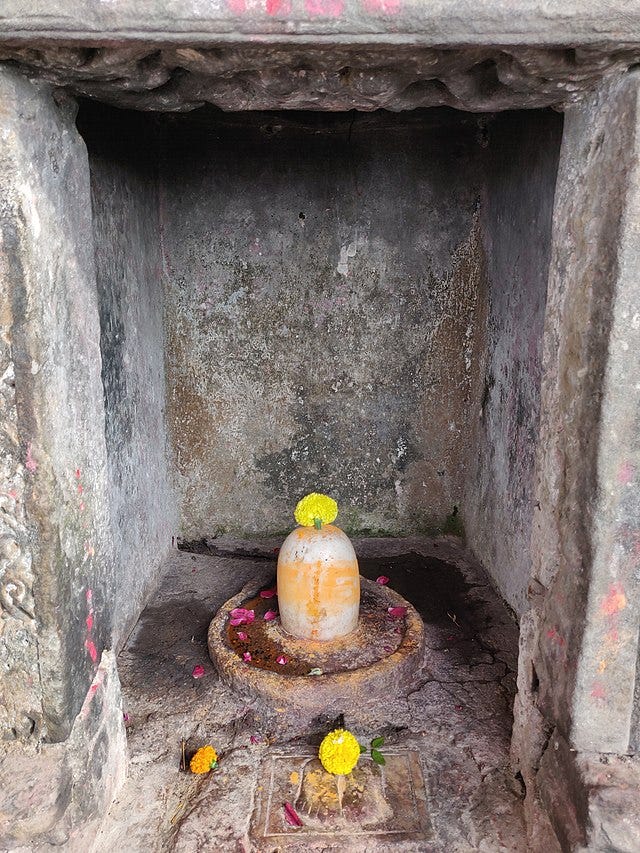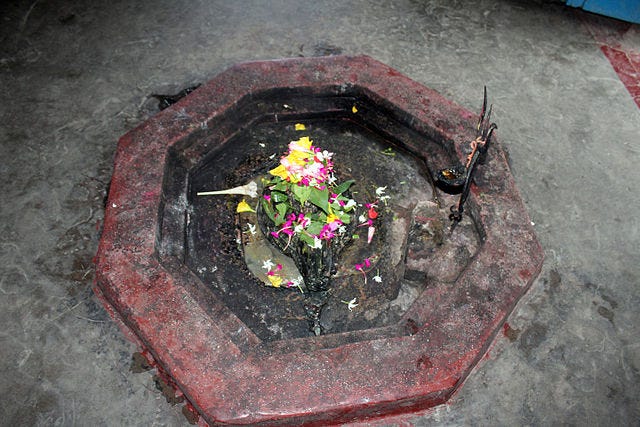God above, God below: a comparison of visual forms
A personal take on two different approaches to conjuring God
This is a personal opinion piece, a report on some feelings, and a noticing. It’s not anti-Christianity or Hinduism or pro-Christianity or Hinduism. Religion is religion, well, kind of (Hinduism is actually a very different kind of religion to Christianity, but that’s another story); all systems of faith, belief and practice are wildly diverse and context-specific, and every individual practice is specific and private.
I was brought up in a nominally Christian country, and was even sent to Sunday school, but no-one in my family went to church apart from at Christmas, and no-one believed in God. I was interested in churches and curious about what they were for from very young age, but I found them gloomy and cold. By the age of twelve I had decided that I couldn’t find anything in Christianity to relate to, and began to notice things about Christian attitudes to other ways of being which seemed to me to be exclusive and dictatorial.
I fell in love with India on my first trip there at the age of 21. I have a degree in Indian philosophy, art and architecture, but have never personally been involved with the teachings of any Indian gurus, or any of the practices of Hinduism. Clearly, as I look at my examples of different visual expressions from these two different traditions today, I’m not neutral or unbiased.
Back in April of this year,
wrote about the image above: The Glorification of Saint Ignatius (1691), by Andrea Pozzo. I had never seen it before, though I’ve been in many Italian churches and found myself looking up at milder versions of the same idea. I know what it feels like to stand underneath such a thing; I can feel the cold marble under my feet, I can smell the candle wax burning. I can imagine the height of this ceiling.My first reaction to this image was to be astonished at the technical proficiency of such a work. Not only that something so huge can even exist on a church ceiling, but the extraordinary illusion of three dimensional space, and the way that the figures appear to be falling through it, towards the heads of the worshippers below. The colour is incredible.
My second reaction was a deep recoil from everything that I associate with such an image, and such a place. The only thing I could see was the painting’s upward focus; the enormous amount of time, thought and labour that had gone into creating this extraordinary fantasy world high above the heads of those down below. This world had no connection to anything that any human could feel or see. It was somewhere else, populated by people who had no use for gravity, no need for earth. The floating people, many half-clothed, some with wings, were suspended beneath an important male (Ignatius Loyola) who was emanating rays of light and looking up at the vanishing Christ; still carrying his heavy cross, as he ascended to an even higher place, indicated by the fading of the bright colours into pastel pinks and blues. Everything was up, up and away, straining the necks of the people down below, pulling them away from their fleshly corporeality, from the earthy reality of the gritty soil below their feet.
The painting is designed to overwhelm, to wow, and to teach. This was the power of images back then, the power of the Church to use beauty and colour and skillful depiction of form as a tool for underscoring its teachings and keeping people in their place.

Months after seeing The Glorification of Saint Ignatius, I was looking through some photographs from India, when I realised that one of the forms of Shiva, the lingam, could be seen as the exact antithesis of the upward gaze that so disturbed me in the painting by Pozzo.
From Wikipedia:
A lingam (Sanskrit: लिङ्ग IAST: liṅga, lit. "sign, symbol or mark"), sometimes referred to as linga or Shiva linga, is an abstract or aniconic representation of the Hindu god Shiva in Shaivism.[1] The word lingam is found in the Upanishads and epic literature, where it means a "mark, sign, emblem, characteristic",[2] the "evidence, proof, symptom" of Shiva and Shiva's power.[1][2][3][4][5][6]
The lingam of the Shaivism tradition is a short cylindrical pillar-like symbol of Shiva, made of stone, metal, gem, wood, clay or precious stones.[1][7] It is often represented within a disc-shaped platform,[1][8] the yoni – its feminine counterpart,[9][10] consisting of a flat element, horizontal compared to the vertical lingam, and designed to allow liquid offerings to drain away for collection.[11]
The lingam is an emblem of generative and destructive power. While rooted in representations of the male sexual organ,[12] the lingam is regarded as the "outward symbol" of the "formless reality", the symbolization of merging of the 'primordial matter' (Prakṛti) with the 'pure consciousness' (Purusha) in transcendental context.[13] The lingam-yoni iconography symbolizes the merging of microcosmos and macrocosmos,[10] the divine eternal process of creation and regeneration, and the union of the feminine and the masculine that recreates all of existence.[11][14]
In a temple, the image of a lingam may be simple, or it may be decorated and ornate. The basic visual idea though is a simple pillar of stone, growing out of the earth. Sometimes raised on a plinth, the lingam is made of material similar to the temple floor, and is usually not elevated very far from that floor, sometimes even sunk into it.
The Italian painting dazzles with blue sky, flashing forms and holy sunlight, promising a higher world to come, and later. The Shiva lingam is generally in the dark centre of a temple, which the worshipper has to approach gradually through a series of enclosures or halls, slowly leaving the light of the outside world behind them.
The Italian painting says, look up, look up, subdue your sinful body and focus upon this story. The Indian image focusses attention inwards and downwards, connecting the human heart to stone and earth; invoking the presence of a universal primal energy, which includes the worshipper, now.
Am I romanticising? Of course I am. I can’t ‘represent’ Hinduism to you. I’m an outsider to that tradition, and I can only receive what it suggests to me, work with my own feelings and responses, my own interpretations of its figures and symbols.
Hinduism is not an easy thing to represent, even for a Hindu. Unlike Christianity and Islam, its origins are multi-stranded. There was no moment in time when Hinduism was born. It has no founder, and the central text that many Hindus claim today is in fact a fairly recent evolution, emerging from the relatively recent challenges of colonialism and the need to create a resistant identity.
What is the form of Shiva that is present in the lingam? How do Hindus understand it? Is it an idol, is it a symbol, is it a god, is it God? You will find no clear answer to this question, because there is no unified group of Hindus, but instead many schools of philosophy, many sects, many practices. Some say that images like this are ‘for the common man’, because he (she) can’t understand a God with no attributes; others follow detailed steps of complicated ritual designed to attract God and install him or her in a particular place. Still others say that God is everywhere, but more present in particular naturally-occuring forms of stone. God can descend into (or perhaps become concentrated in) objects, and also into people, even though he or she is also present in the human heart.
There are no simple answers to the questions that we have as outsiders. I’m not looking for answers, or to understand. I just noticed the upward and downward focus of these examples from the two different traditions, which are themselves hugely diverse, and which vary according to local histories and the conventions of different groupings or sects.
Lest you think that there are any general truths here, I need to say that there are also enormous images of Indian gods that tower above people (though I think these tend not to be inside temples). There are also, of course, many small Christian shrines, but these may often be on sites originally held sacred by much older, earth-based systems of belief.















I find this all very interesting! Thank you for presenting the interesting contrasts and your thorough observations.
I was not familiar with the concept of lingam. The first thing I thought of was its similarity to ‘lingers’ as a word, encouraging prolonged contemplation, and the presence of the thing itself lingering low to the ground. I can honestly say I do not quite get ‘the capture of fluids’ trough which to me looks like a yoni, as being anything but the compliment to the other. Then the thought of capturing fluids… well I think you get where I am on this one.
Needless to say, my overall sense of Hindu deities and worship observes a greater sense snd identification with sex, the sexes, inclusion of the two forces in a balancing act appearing much less patriarchal than Christianity. Though culturally I am aware of caste and the most likely very designated roles of the sexes, and don’t doubt the power of that lingam thrust is, for a moment, not always the last word when it comes to hierarchy.
There is a sense of elevation I believe the Christian art of the High Renaissance strives toward unlike that achieved in most other. Rogue’s recent posts exploring mosaic, the art of the apse, the evolution of human v mathematic representation in subject all brought together a kind of wave for me. A sin/cosin of the periods moving toward more conservative rigorous patriarchal representation and then away from it. A pendulum swings over the centuries shifting human relationship to the ‘Divine’ as needed. We also saw some distinct relationships to politics and policy, if you knew what to look for. The council of Nicaea in 325 effectively nullifying what was left of any pagan ritual left in consideration of consolidation, also turning Christ into a form of non-man while adding the storyline Mary must be a virgin because Jesus was begotten, not ‘made.’
As I listened to her (they require listening considering the length) I could hear the schism occur in the art as well. From there, humanity was removed and dictate reigned. All this to say that politics and policy ordained what we perceive as the goals of the art you flinchingly respond to. Not force, nor nature, nor humanity.
Your distaste for doctrine is well founded. The organic nature by which Hinduism and its representational practices have evolved over time is in its way, more attractive in spirit, while the extraordinary achievements in representational art backed by tremendous monies is quite astounding as visual achievement. Spiritually, I lay in the realm of rose windows if I must loiter in cathedrals. There, for me, lies the true spirit 😉